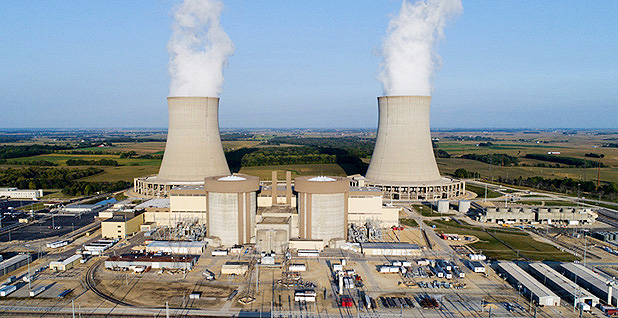A screenshot from the Kurzgesagt YouTube video
The German animation studio Kurzgesagt released a new video to its English YouTube channel last week to answer the question, “Do we need nuclear energy to stop climate change?” The studio’s channel on YouTube is self-described as a small team working to make science look beautiful. Its videos discuss a variety of scientific, technological, philosophical, and psychological questions, and it has more than 14 million subscribers. The channel recently discussed the question of deaths caused by radiation—spoiler alert, nuclear is among the safest of all energy production.
Waste handlers take radiological readings as a crane lifts containers from a TRUPACT-II cask in the contact-handled waste bay at WIPP. Photo: DOE
The Waste Isolation Pilot Plant in southeastern New Mexico is once again accepting shipments and processing transuranic waste following a two-month annual maintenance outage. According to the Department of Energy, WIPP is back to accepting five waste shipments per week, with post-pandemic plans to increase shipments to 10 per week.
Alberta Premier Jason Kenney at an online event on April 14, after signing an agreement on small modular reactor development. Photo: Chris Schwarz/Government of Alberta
Alberta Premier Jason Kenney has added his signature to a memorandum of understanding on small modular reactor development that was signed in 2019 by the premiers of New Brunswick, Ontario, and Saskatchewan. Kenney signed the document last week at a virtual event that also promoted the release of Feasibility of Small Modular Reactor Development and Deployment in Canada—a study formally requested as part of the MOU.
Indian Point nuclear power plant in Buchanan, N.Y.
The State of New York will withdraw its lawsuit against the transfer of Indian Point’s license to Holtec International for decommissioning under a provisional agreement signed on April 14. In exchange, Holtec has agreed to maintain a minimum of $400 million in Indian Point’s decommissioning trust fund for the next 10 years.
April 16, 2021, 2:59PMUpdated April 19, 2021, 10:56AMNuclear News The Byron nuclear plant is currently slated for permanent closure in September. Photo: Exelon
A research and consulting firm hired by Illinois governor J. B. Pritzker’s administration to scrutinize the financial fitness of Exelon’s Byron and Dresden nuclear plants approves of limited state subsidies for the facilities, according to a redacted version of the firm’s report made available yesterday.
Federal and contractor officials participate in a groundbreaking ceremony for the WEPAR project on April 7 at the Y-12 National Security Complex in Oak Ridge. Photo: DOE
A project to reduce by approximately half the high-security protected area at the Department of Energy’s Y-12 National Security Complex in Oak Ridge, Tenn., will avoid millions of dollars in costs and accelerate cleanup, the DOE’s Office of Environmental Management (EM) announced.
A retired USGS geologist shares his experience of working on the publicly misunderstood nuclear waste repository and its geology.
The author on a typical day at Yucca Mountain, with Solitario Canyon and the flat-topped repository block seen in the background.
SRNS engineers (from left) Will Jolin, John Bradley, and Joao Cardoso-Neto discuss a plan to move and repurpose equipment used at 19 soil cleanup sites. Photo: DOE
A project to passively remove nonradioactive contaminants from the soil and groundwater at the Department of Energy’s Savannah River Site in South Carolina is coming to an end, as workers prepare to remove solar-power “plugs” from 19 soil remediation locations at the site.
The NRC-licensed independent spent fuel storage installation at Zion, Ill.
A radiological worker surveys the inside of a TRUPACT-II containment lid during waste handling operations at WIPP. Photo: DOE




















